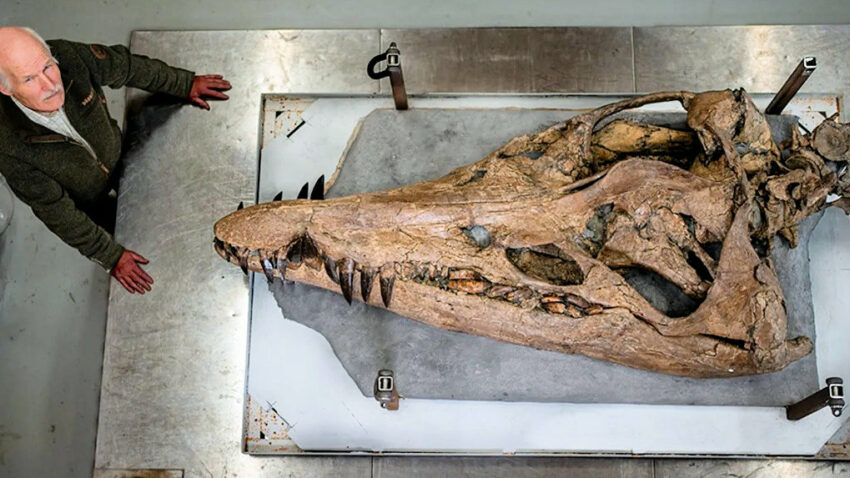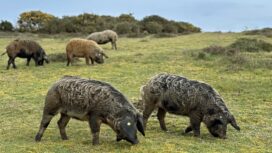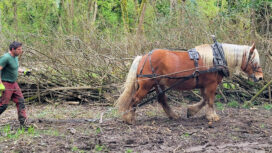The day after Sir David Attenborough tells the world about the most dangerous creature ever to swim along the Jurassic Coast, visitors to The Etches Collection in Kimmeridge, Dorset will be able to get face to face with its skull.
The complete skull of a previously unknown pliosaur from 150 million years ago, which was essentially the Tyrannosaurus Rex of the seas, is going on display at the museum from Tuesday 2nd January 2024. The documentary Attenborough and the Giant Sea Monster, will be broadcast on BBC One at 8 pm on Monday 1st January 2024.

Sir David Attenborough spent several days filming in Purbeck for the New Year’s Day programme
BBC 1’s Sea Monster show filmed on Jurassic Coast
In a top secret operation filmed by the BBC, the one ton skull was extracted from the cliff 12 metres above the beach near Kimmeridge, over three weeks in summer 2022.
It was then taken to the workshop of Kimmeridge fossil collector Steve Etches where it was meticulously cleaned up and where Sir David Attenborough recorded a remarkable documentary.
Attenborough and the Giant Sea Monster documentary tells of the discovery of a lifetime, an abseiling operation to rescue it and the monster which has since been revealed.
Although the new species of marine reptile has yet to be named, Steve Etches would like it to be called after local landowner James Gaggero, who didn’t hesitate to allow a team of fossil hunters to rescue the skull, and then donated it to the Etches Museum.
It is already drawing worldwide attention as the most complete and best preserved skull of an apex predator which could stalk its prey in the darkest waters just by using sensors on its skin – and ate anything that it came across.

Purbeck’s pliosaur closes in for the kill in a reconstruction made for Attenborough and the Giant Sea Monster
“Absolutely top of the food chain”
Palaeontologist Steve Etches said:
“It is larger than a T-Rex, with probably about 130 teeth which were perfectly evolved for killing, cutting and crushing. It’s not a dinosaur, it’s a marine reptile, but it was absolutely the top of the food chain in the Upper Jurassic, and apparently the largest carnivorous reptile that ever lived.
“This is the most evolved pliosaur that has been found in Kimmeridge clay, with a large head crest which others don’t have, a large third eye on the top of the skull to sense light and pressure and sensory pits on the snout that could have detected turbulence in water.
“It would have preyed on absolutely anything – ichthyosaurs, plesiosaurs, its own kind. We have evidence that they ripped apart other pliosaurs from a very distinctive bite mark that’s not replicated by any other marine reptile.
“Although this specimen has a two metre skull, we think it may not have been fully adult and there is evidence to suggest that there would have been larger ones with skulls up to three metres long.”
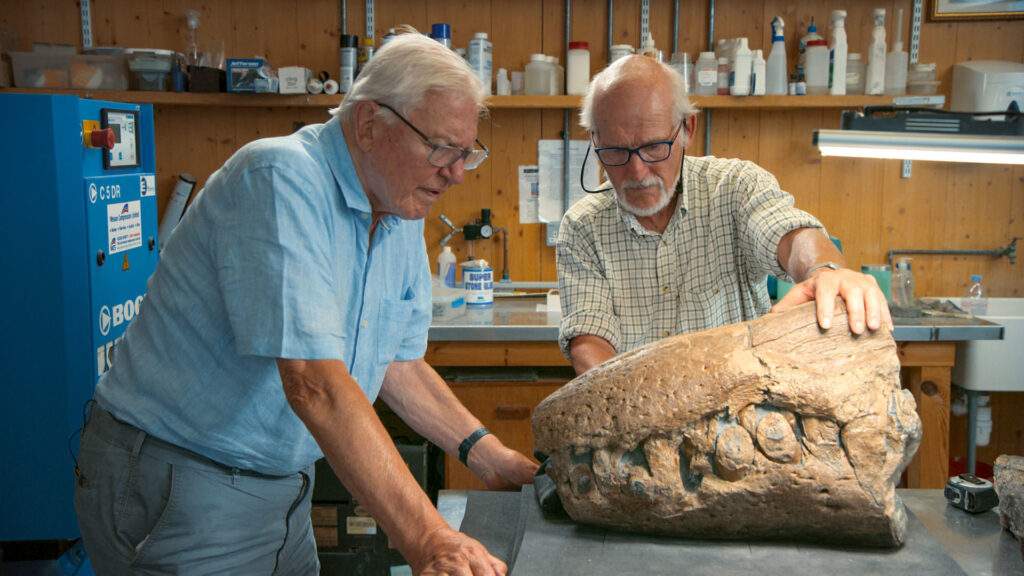
Sir David Attenborough and Steve Etches examine the skull at Etches Collection in Kimmeridge
They knew it was a special find
The story began in spring 2022 when Philip Jacobs, a local artist and fossil hunter, was walking along the Jurassic Coast near Kimmeridge and came across what he recognised as a fossil snout.
Covering it up, he went to the home of Steve Etches to tell him about the discovery and the following day they went back to examine it together.
Although it was just the tip of the snout it was almost too heavy to lift, yet they knew that it was a special find and also – because the jaws were closed – that the rest of the skull had to be somewhere close by, still in the cliff face.
Sending up a drone to investigate, they spotted the point it had fallen from, about halfway up the 25 metre cliff and only accessible from above.
A specialised climbing firm agreed to set up an abseiling operation to get down to the skull, gave Steve some training, worked out a recovery strategy with farmer and engineer Rob Vearncombe and by August 2022 were ready to start the delicate operation.

Sir David Attenborough and Chris Moore watch the cliff face rescue in progress
A personal friend of Sir David
Steve Etches said:
“Chris Moore, who helped with the extraction, is a personal friend of Sir David Attenborough, and had worked with him in the past on a programme about a sea dragon, an ichthyosaur, that he had found.
“After that, Sir David had asked to be told if anything else of interest was found, and of course he has the power to sway the BBC, so that’s how they came on board.
“He came out to film while we were recovering the skull, although I didn’t see him then as I was under the cliff working. He came back here to my workshop a couple of times with BBC cameras – he is a very good presenter, his mind is so active!
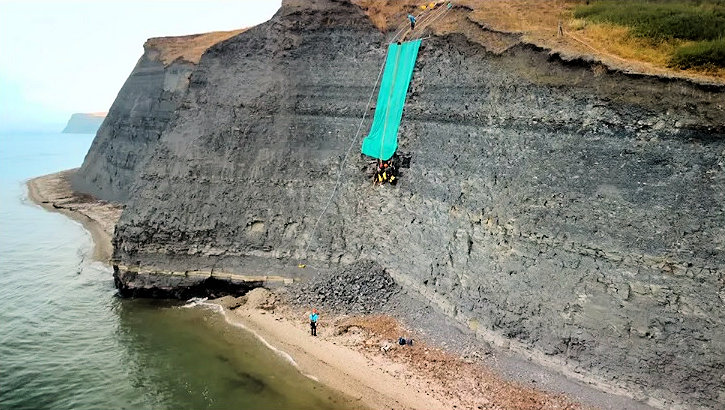
The excavation took place over three weeks during a blazing hot August in 2022
“Very physical work at hottest time of year”
“It was very physical work at the hottest time of the year, we could only do five hours at a time, and it was a 15 metre drop down a sheer cliff with overhang, so we had to clear the cliff off as we went down, otherwise we would have brought it down on top of us.
“We had realised the creature was preserved upside down, so it had hit the sea floor on its back, so we needed to engineer a way to get it out of the cliff and then up the cliff.
“That was where Rob Vearncombe came in, although he’s a farmer he is also an amazing engineer and the apparatus he designed was a work of art.
“If it hadn’t been for Philip finding the tip of the snout and Rob getting it out of the cliff for us, we wouldn’t have this discovery here today.”
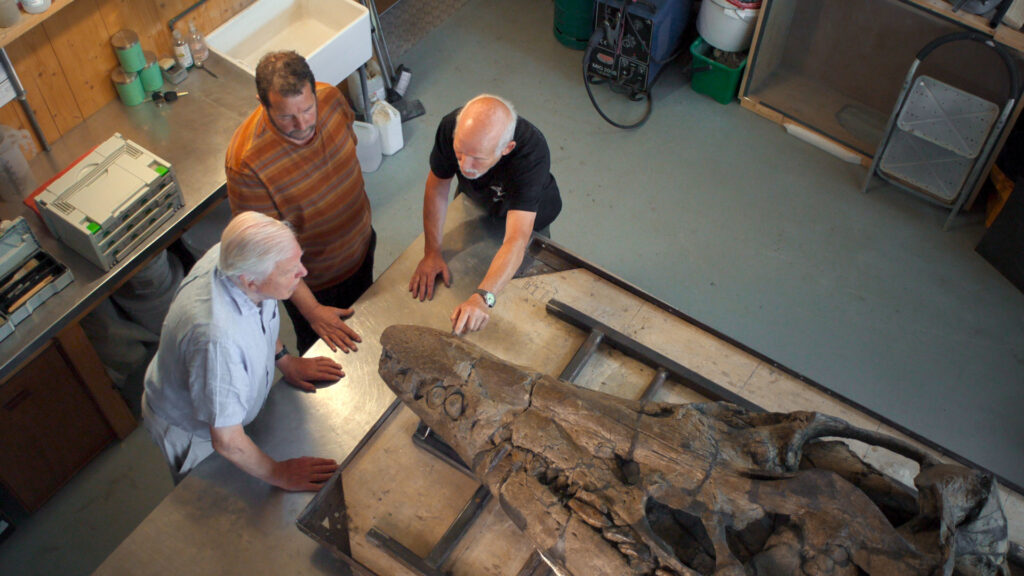
Sir David Attenborough, Chris Moore and Steve Etches discuss the skull at the Etches Collection
“I would love to get the rest of the body”
Steve added:
“It took three weeks to get the skull out. We are grateful we got the skull, but I would stake my life that there is the rest of the body behind it and I would love to get it, but it is a project for another day.
“It really should come out because the cliff is eroding away so quickly by several feet a year and it won’t be very long before the rest of the pliosaur drops out and gets lost. It’s a once in a lifetime opportunity.
“Scientifically it seems wrong to leave it there to fall into the sea in bits, and it would be easy enough to do, but there would be a minefield of bureaucracy to overcome.
“You would just get an excavator, excavate the cliff and within three or four days you would have it, but there would probably be an outcry from people.
“But its potential is phenomenal, this skull is probably the finest one that has ever been discovered, a completely new species and there is interest in it from virtually every other country in the world.”

The 150 million year old pliosaur skull will go on public display at Kimmeridge from Tuesday 2nd January 2024
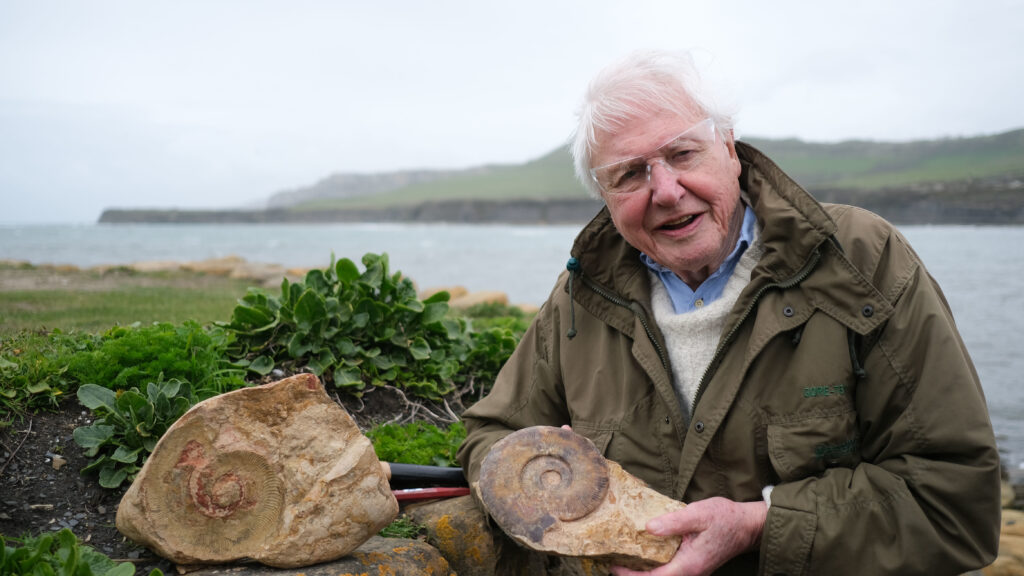
Sir David Attenborough with ammonite fossils while filming at Kimmeridge in 2022
“Able to stalk its prey just by using its skin”
Pliosaurs lived between 200 million and 65.5 million years ago, and could grow to more than 40 feet long.
They were larger than any other creatures in the seas at that time and with extremely powerful jaws, massive flippers and dagger-like teeth, they could quickly hunt and crush prey into bite-size pieces.
Sir David Attenborough, who filmed on top of the cliffs at Kimmeridge as well as at the Etches Collection, said:
“Each of its four flippers would have been two metres long, driving it through the water at great speed and enabling it to accelerate up to 30mph, making it one of the fastest animals in the Jurassic seas.
“Sensory pits found on our pliosaur’s snout may have acted like miniature pressure pads detecting the turbulence produced by ichthyosaurs as they swam through deep water.
“In effect, our pliosaur was able to stalk its prey even in the darkest depths just by using its skin.”
BBC Breakfast is expected to send a team to the museum on New Year’s Day for a special report and the pliosaur skull will go on public display from Tuesday 2nd January 2024.

Closing in for the kill, the most dangerous predator of the Jurassic which may be named after a Purbeck landowner
Watch the BBC trailer
Watch video of what exactly a pliosaur was
Further information
- Find out more about the Etches Collection at the Kimmeridge museum’s website
